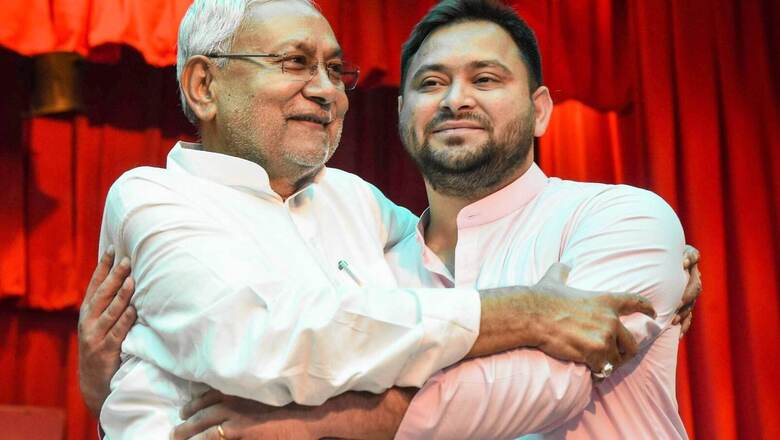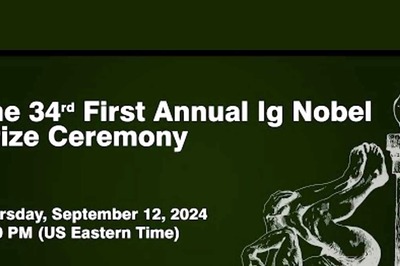
views
A seasoned chameleon can’t stop changing colours. Similar is the case with Bihar’s Raja Babu — or Sushasan Babu as the sycophants would like him to be addressed — Nitish Kumar. On Tuesday, Nitish Kumar finally pulled the plug on the topsy-turvy see-saw game in Bihar, breaking the alliance with the NDA, joining hands with the RJD, and taking oath as Bihar’s Chief Minister for a record eighth time.
Nitish Kumar’s petty betrayal is precisely the weak tea we would expect from him, considering his long-standing history of trapesing between allies to cling to the highest seat of power in Bihar.
On March 3, 2000, Nitish Kumar was anointed for the first time as Chief Minister of Bihar, with the backing of the BJP-led NDA. After the tragic Gujarat riots of 2002, many allies broke ties with the Atal Bihari Vajpayee government at the Centre, but Kumar stood by him. Remaining faithful to the BJP, or rather the Chief Minister’s position, Nitish continued his alliance with the BJP from 2005 to 2013.
At a press conference, after 11 long years of Gujarat riots, and just a week after Narendra Modi was named chief of the BJP’s 2014 Lok Sabha campaign, Nitish Kumar said, “What happened in Gujarat can never be forgotten and it can never be pardoned.” Presumably, Nitish couldn’t afford to lose his Muslim votes.
In 2013, Nitish Kumar left his long-time ally, the Bharatiya Janata Party, for the first time, to form a grand alliance or Mahagathbadhan, with the RJD, now led by Lalu Yadav’s son and scion, Tejashwi Yadav, and Congress for the 2015 Assembly elections.
The given reason was the need to uphold “secularism”, but Nitish’s growing ambition to occupy the national stage was glaringly conspicuous and couldn’t have been possible by sticking with the assertive and dominant BJP. Under his leadership, the Mahagathbandhan worked and saw a stunning victory in the 2015 Bihar Assembly elections.
After the polls, RJD emerged as the largest party in the Mahagathbadhan, and Lalu Yadav’s only intent was to settle his heirs in politics. For Bihar, Lalu Yadav was in the driver’s seat while Nitish Kumar was reduced to his puppet. But, as a pompous individual and a power-hungry politician with no ideological foundation, Nitish had it coming! Upon realising his mistake, the seasoned politician decided to make amends.
With the CBI slapping corruption cases against the Yadav family, Nitish broke ties with the RJD, underlining his “zero tolerance for corruption policy”, and walked out of the alliance.
“Whether I live or die, or will go into oblivion rather than ally with the RJD again, it is impossible now. The RJD has broken my trust. This chapter is over,” said Nitish Kumar on the floor of the Vidhan Sabha.
In fact, Nitish Kumar’s feud with Lalu Yadav dates further back to the 1990s, when Kumar called him out for his “dictatorial ways”. Kumar resigned as Chief Minister only to be made leader again within 24 hours by the Bharatiya Janata Party and continued till the end of his tenure, returning to the same Narendra Modi camp which he had earlier claimed to be responsible for the 2002 Gujarat riots.
Nitish even expressed his deep admiration for Prime Minister Narendra Modi. In fact, in the 2020 Bihar elections, the JDU-BJP alliance won 43 and 74 seats, out of the contested 115 and 110 seats, respectively. While the BJP enjoyed a strike rate of just about 67%, the JDU ensconced around 37%. Nitish was aware of his party’s dwindling presence in the state and became Chief Minister only with the grace and benevolence of the BJP.
In the last five years, 25 million Jan Dhan accounts were opened; 9 million households were provided gas cylinders under the Ujjwala scheme; 6 million farmers in Bihar were beneficiaries of the PM Kisan scheme; and 100% electrification of Bihar households was completed, all under the central schemes. In fact, Narendra Modi rescued state ally and CM Nitish Kumar from anger and anti-incumbency with the resounding faith of the people in the government’s strategic lockdown and its management.
Unfortunately, Nitish, in his inexorable and relentless greed for power, reduced Bihar’s politics to ‘who gets the throne’.
What is surprising is that Nitish has always been welcomed by the parties he has betrayed earlier, and is handed the CM chair on a platter. Tejashwi Yadav, who used to refer to him with the monikers “paltu chacha” and “bahurupia“, is back with Nitish, who has been sworn in as Chief Minister for the eighth time in 22 years.
Friends, foes, and friends again! So much so that the term “renegade” has shrunk and debased, and irony has died a million deaths. In fact, Yadav had described Nitish as a “chameleon-like” character and ruled out all possibilities of him returning in an alliance. In July 2017, Nitish had publicly accused his deputy and Lalu’s son Tejashwi Yadav of corruption, and made the most dramatic exit from the much-feted Mahagatbandhan to retain the “moral high ground”.
Nitish has allowed himself to be seen as mercurial, diminishing his party’s significance in the state polity.
Many theories float around, deciphering the untimely split. Some believe that Kumar suspected the Bharatiya Janata Party’s possible future move to pull a Maharashtra in Bihar and feared facing the same fate as Uddhav Thackeray. However, the BJP has denied this suspicion, pointing out that even if the JDU were to split, they wouldn’t be able to form a government.
But one of the theories does stand out among the rest. Many believe that defector Nitish sees this as an opportunity to nurture his prime ministerial ambitions again, with an opposition leadership vacuum ahead of the 2024 general elections, and hence being the best possible consensus candidate of the weak opposition camp to challenge Prime Minister Narendra Modi.
With West Bengal CM Mamata Banerjee occupied with corruption scandals in her state, Nitish, being a leader from the cow belt, is likely to have greater appeal than Mamata Banerjee. However, Nitish’s minions and the opposition’s idea of this gambit is flawed in several aspects. For one thing, Nitish’s latest U-turn has only ridiculed the voter’s mandate, his declining reputation as a self-serving and power-seeking politician, and cemented “Paltu Ram” to his name due to his unfaltering rapacity for power.
Nitish’s latest egress observed no heartburn within the BJP, albeit, it might cause only a minor hiccup for the party with regards to 2024 polls, it will indubitably open a new independent window for them in Bihar. Perhaps the saffron party had envisaged the breakup a mile away.
For the 2024 Lok Sabha elections, there are thousands of more nuances, hundreds of more moves yet to unfold, but Nitish has reached his final innings. Times have changed. In the age of social media, the ghosts of the past haunt many. In politics, ideology is and ought to be supreme, and Nitish’s record of stitching unnatural alliances and switching sides indicates his party’s pretentious nature and a dearth of ideology.
Plus, there is a lack of vision in grooming second generation leadership, bolstering one claim — that the party is a private limited corporation meant to serve only an individual or his commune. Nitish has overstretched his limits of ideological infidelity and has choked the people’s mandate to its last breath.
Yuvraj Pokharna is an independent journalist and columnist. Yuvraj Pokharna is a columnist and social activist. The views expressed in this article are those of the authors and do not represent the stand of this publication.
Read the Latest News and Breaking News here

















Comments
0 comment